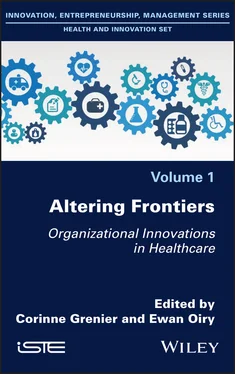Chronically ill people who, depending on their illness(s), spend an average of 5 to 10 hours a year in care with health professionals, while in that time, they and their loved ones spend up to 6,250 hours of care. This knowledge of patients has become a social fact (Durkheim 1988; Flora 2012; Jouet 2014). This chapter therefore deals with what is being organized as a consequence of this ongoing transformation in the organization of our societies as an extension of the changes largely shaped by the rise of science and more particularly of technoscientific approaches in the field of health (Jouet et al. 2010).
1.2. From “empowerment” to the “patient revolution”, an international trend
With the medical model, which can be described as “organic” 2 , imposing itself in the institutionalization of care in Western countries, and relegating the educational dimensions of care to the background, at the end of the 20th century and because of the link between prophylactic policies and the emergence of patient knowledge, it was called into question by the modification of the place of patients’ knowledge in the healthcare system. As new figures for patients and citizens who disseminate this knowledge are increasing in the 21st century, it is because of the profitability of their involvement in the management of healthcare systems (Boivin et al. 2014). Historically, it was the reaction of patients to the management of AIDS that enabled health democracy to take root and to articulate patient expertise and public health policies. However, the first group of patients mobilizing empowerment processes was initiated in 1934, within the Alcoholics Anonymous movement.
DEFINITION 1.1. Empowerment. – The process by which individuals and groups act to gain control over their lives and thus gain greater control over decisions and actions affecting their health in the context of changing social and political environments. Self-esteem is thus strengthened, critical thinking, decision-making and action capacity are promoted. Even people with few abilities or in precarious situations are considered to have strengths and resources. This process cannot be produced, only fostered .
It was at this very moment that the cornerstones were laid for a new type of exchange based on informal and formal practices between patients. The organizational model that emerged from this was to be extended to other groups, such as drug users in the 1950s and people living with HIV in the 1980s. This phenomenon was then transposed into self-help and self-empowerment movements of user groups in several other addiction pathologies (for example, alcohol in 1935, drugs in 1953, eating disorders or compulsive gambling behavior). This type of interaction, based on mutual aid, information sharing between patients, peer training and developing a global approach to the individual, has gradually challenged and then upset the pyramid of medical knowledge and power alone as a source of healing and disease management. It has also made it possible to meet patients at the very site of their addictions.
The organization of this movement has been formalized according to already operational models, such as those of learned societies or large charitable organizations. This movement thus took this form while, paradoxically, throughout the 20th century, medicine became institutionalized, raising health as a primary value in society in large part thanks to technological discoveries that supported the medical approach, affirming technicality as the spearhead of modern medicine. This institutionalization is accompanied by the displacement of knowledge and care practice from the family sphere to the group and societal spheres, a process which, amplified by societal transformations, sees the development of women’s work taking them away from the family sphere. In this redistribution of knowledge, roles and powers, resorting to a “family doctor” and hospital services will become the norm, giving doctors and the medical institution the possibility of seeing themselves higher in the hierarchy because they are able to defy pain and death (Foucault 1963).
In this process at work, the women, ancestral holders of a “care-taking” inherited from one family member to another, used to practice bona famae (reputable) remedies, occasionally calling on outside practitioners (binders, healers, etc.) to intervene most often in the final stages of the disease during which the prognosis proved fatal and these forms of knowledge were lost. To conclude on the elements leading to a shift in the distribution of care knowledge, it is necessary to highlight: (1) the death of family members in specialized institutions, first in the hospital where the majority of elderly people died during the 20th century, then to dedicated institutions when signs of old age appeared; (2) the appearance of social protection systems – driven by the economic development of our societies – which, although different from one country to another, provide social added value replacing support cells at the family level.
Economic developments also penetrate the world of healthcare, as the pharmaceutical industry developed and grew throughout the century to become part of the international healthcare system by developing global pharmaceutical trusts whose missions are research and marketing of medicines.
In reaction to this medicine, which is carried and dominated by techniques and technologies, both in the care and in the organization of care, a movement of humanization emerges as a compensation of the dominant medical model with the appearance of listening and accompaniment techniques during the 1970s.
Health professionals are organizing themselves to intervene in this trend, first of all outside the institutional framework that protects these new approaches. Not everything concerning patient information and education has yet been translated into international (WHO 1986) recommendations. At the societal level, new public health policies are needed. The increase in the number of people living with chronic diseases raises the question of the involvement of the patient in the management of his or her treatment. Beneficial effects have been recognized by studies. This involvement improves adherence to treatment in multiple pathologies, and doctors are therefore seeking to develop tools to increase it. This transformation of patient care emphasizes the need not only to inform but also to educate the patient in order to be as close as possible to a so-called “informed consent”. This notion of consent initially emerged for research during the Second World War and was the first time that the Nazi regime began experimenting in this field and questioned the behavior of medical doctors who put forward the concept of bioethics. In the course of this process, the patient then began to demand, beyond mere information, a sharing of the decisions that would be taken thanks to free and enlightened information and the right to self-determination.
However, it was during the 1980s that an upheaval was to take place in the attempt to rebalance knowledge and medical power in the context of relationships with patients and populations. It is the result of the emergence of a disease against which, at first, medicine remained powerless: HIV/AIDS. The patient-stakeholder relationship then established itself during the last two decades of the 20th century. This movement added a new element to those previously described and driven by the movement or movements of patients (mutual aid, information and training): the use of an activism that claims to play the role of reformer within a changing society – the information society and then the knowledge society, in the 21st century.
The socialization of action in the field of health then became a fact of society. The approach to health was profoundly modified by the action of these new patients who, as early as 1983, set out new demands through the Denver Principles. They then expressed the need for their participation in everything that concerned them.
Читать дальше










